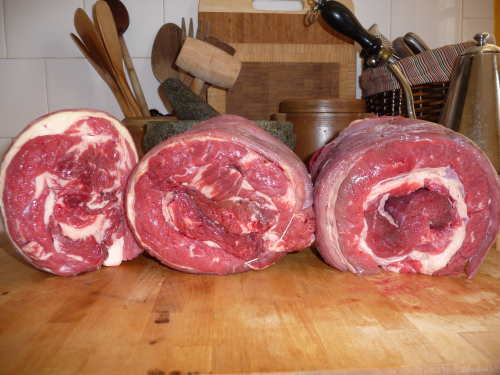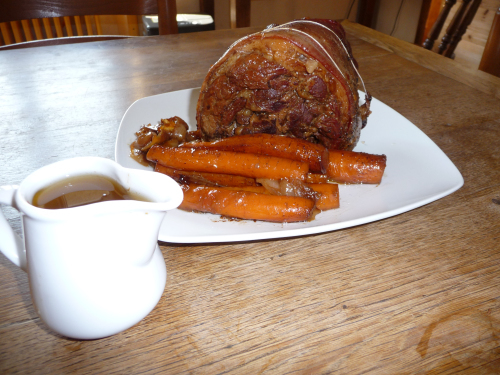My Friendly Local Butcher.

I love beef. Trouble is, we haven’t yet found a good local supplier near
to us. They’re around, but tend to sell in large quantities, and
frankly bulk steer is not my thing – you can have too much of a good
thing you know.
So, for the moment, I buy from the local LeClerc supermarket. – No
food-crime committed there I feel.
In their favour, the local supermarkets buy a large amount of their
fresh products locally, and the provenance of the food is quite easy to
trace- a lot of the beef I buy is from herds around Parthenay, which is
about 25 miles from here – we’re in the heart of goat county here. We
even have a beef supplier here in the village who is one of the forty
three suppliers of local produce to the local Le Clerc at Bressuire.
Can’t get closer than that eh?
That said, I am continually confused with the differing cuts that the UK
and France have to offer.I am not overly struck on their small roasting
joints, where the “fat” is wrapped around from another part of the
animal.
Anyway, I digress.
I was recently loitering around the meat counter at aforesaid
supermarket the other day and I spotted one of the butchers cutting up
beef “potrine” for the trays about to go on sale – it is a thinly sliced
cut that is used for quick grilling or BBQ treatment.
As I gazed on, the penny (or centime?) slowly dropped that he was indeed
cutting up a brisket joint, but selling it “flat” if you see what I
mean.
I wasted no time and immediately entered into meat negotiations with him
– How would he feel if he rolled one entire piece of “potrine” tied it,
and then cut it into three good sized English style joints?
The whole work area stopped dead. Much discussion ensued ( I was
politely excluded from the heated arm waving and the ever obligatory
Gallic shrugging.) Shortly after, the deal was struck and I was allowed
my whims and I walked away with three fabulous brisket joints weighing
about 1.5 – 2 kilos each.
Here’s how I prepared one of them.
BRAISED BRISKET
INGREDIENTS
1 ROLLED BRISKET (1.5-2 KILOS_
A FEW CARROTS PEELED AND SLICED LONGWAYS
TWO GOOD SIZED ONIONS, CUT INTO QUARTERS
SALT AND PEPPER TO SEASON THE MEAT
A SLOSH OF SHERRY, RED WINE, AND STOCK TO MAKE UP TO 250ML
OLIVE OIL TO FRY
METHOD
1. Chop up the vegetables – chunky is what is needed as they act as a
“bed” for the meat to sit on. Too much liquid in this dish will make it
sloppy and tasteless.
2. . Rub the salt and pepper well into the meat.
3.Fry the brisket to brown all over in a sturdy deep casserole dish – it
would be a good idea to get the meat out about an hour before needed to
allow it to come up to room temperature. Remove from the pan and set
aside.
4. De-glaze the pan with your chosen liquids and allow to bubble and
reduced slightly.
5. Place the vegetables into the bottom of the pan and place the meat on
the top of them.
6. Bring the pan back to the boil, covered, and place immediately into
an oven (220 degrees) for 20 minutes.
7. Reduce the heat to 165 degrees – For Aga owners, place the pan into
the roasting oven on the floor for 20 minutes, and then put the pan
(also on the floor) of the simmering oven
8. Cook for 3-5 hours depending on your oven and your taste – the longer
it cooks, the more succulent it will be – it can be cut up with a spoon
when it has a long slow braise.
9. Remove the meat and vegetables from the pan and pour out the juices.-
skim away the fat.
10 Serve the meat and vegetables with the jus as it is, or if you come
from Wales, make a thick sticky gravy by thickening the reserved fat
with a tablespoon of flour, cook to break down the starch and add the
juices from the pan. Cook on a rolling bubble to let the gravy thicken
up.
TO SERVE <br /"> wp-image-218" height=“375” width=“500"”>
My ideal is lashings of mash – potato or other roots, plus some dense
doughy bread to mop up the gravy. Heaven.
